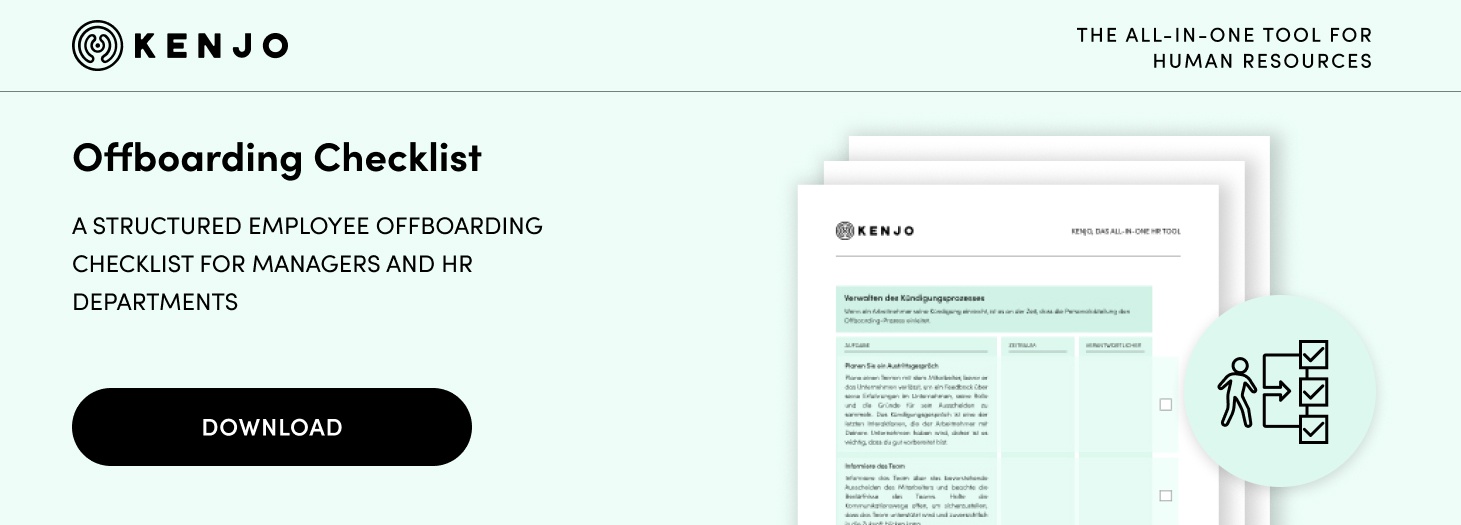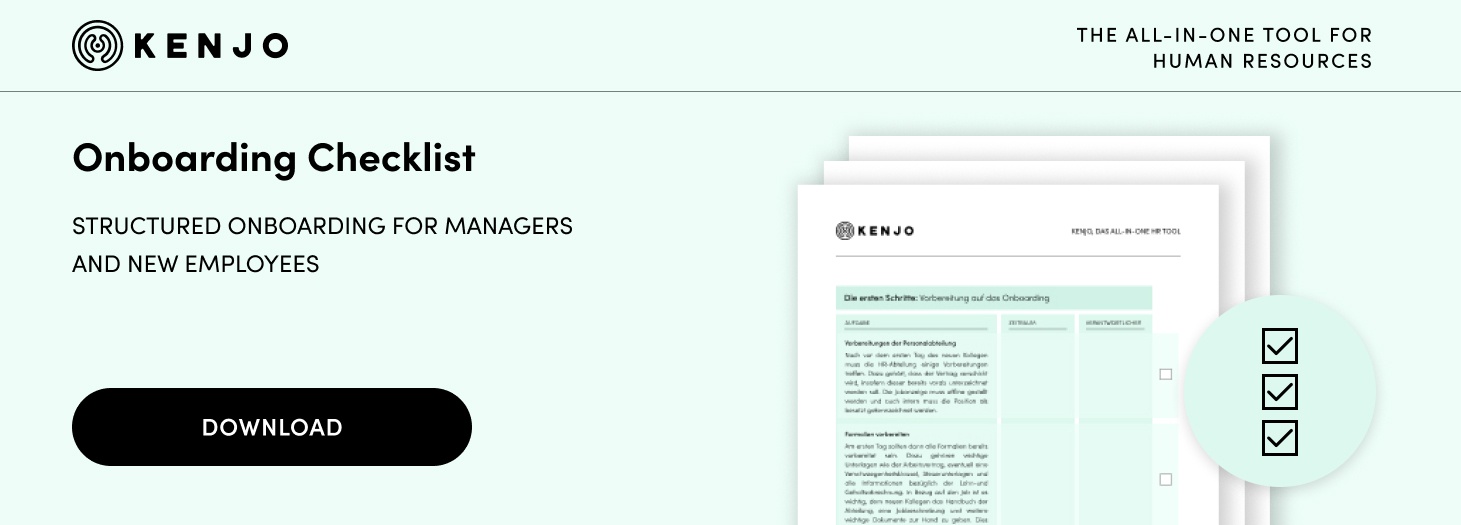Everything you need to know about the Employee Offboarding process (+ free offboarding checklist)

Even the last impression counts, which is why the topic of offboarding is becoming increasingly more important for HR departments. But what exactly does "offboarding" mean? The term offboarding describes the process that should accompany employees when they leave a company and is often the last opportunity for companies to leave a good impression on the employee as well as gather valuable feedback, which is why it is important to address any and all open questions. There are several factors that must be considered when offboarding an employee, which is why we've summarized everything that you need to know about the offboarding process below, as well as included a free offboarding checklist for you to download.
What is Offboarding?
Offboarding is the process that leads to the formal separation between an employee and a company through termination, dismissal, retirement or voluntary departure by the employee. It encompasses all the decisions and processes that are important when an employee leaves and accompanies the employee as they leave the company. The process includes activities such as knowledge transfer, handover of job responsibilities and support during all the processes needed when leaving the company. An employee Offboarding, along with Onboarding, is one of the most important HR tasks in the employee work cycle.
An Employee Offboarding can be a positive experience for both the employer and the employee, as it provides an opportunity for the employer to evaluate the importance of the departing employee to the company and find ways to improve their work environment. For the employee, it can be a chance to reflect on their time with the company and give open and honest feedback about their role, responsibilities and work experience. But offboarding can also help the departing employee to make a smooth transition into their new role. By carefully planning and executing the offboarding process, you as an employer can ensure that all employees have a positive experience, which is also important for the remaining employees.
What is the difference between Offboarding and Onboarding?
Employee onboarding and offboarding are two distinct processes related to managing an employee's journey within a company.
Employee onboarding refers to the process of introducing a new employee to the company and its culture. It is the process of integrating a new hire into the organization and providing them with the necessary tools, resources, and training to be productive in their role. This includes tasks such as completing paperwork, providing access to company systems and tools, introducing them to team members, and providing training on company policies and procedures.
Employee offboarding, on the other hand, refers to the process of managing an employee's departure from the company. This includes tasks such as conducting an exit interview, revoking access to company systems and tools, collecting company property, and ensuring that the employee's departure is smooth and respectful. Offboarding can also involve providing the employee with information about their post-employment benefits and options, such as COBRA healthcare coverage or 401(k) rollovers.
Employee onboarding focuses on welcoming and integrating new employees, while employee offboarding focuses on managing an employee's departure in a respectful and organized manner.
Why is the Employee Offboarding process important?
Employee offboarding is a crucial process for any company as it serves the interests of both the company and the departing employee. From the company's perspective, an effective offboarding process ensures that all company property is retrieved, access to company systems is revoked, and any intellectual property rights are protected. This is important to safeguard the company's assets, minimize potential legal liabilities, and maintain the company's reputation.
From the departing employee's perspective, a well-planned offboarding process can help to ensure that their departure is smooth and respectful. This can help to preserve the employee's professional relationships with colleagues, enhance their career prospects, and maintain a positive view of the company. In addition, an effective offboarding process can provide departing employees with valuable information about their post-employment benefits and options, such as COBRA healthcare coverage, 401(k) rollovers, or severance pay.
Moreover, an employee offboarding process can provide valuable feedback to the company. Exit interviews and surveys can help the company identify areas for improvement and make necessary changes to enhance the employee experience. This can help the company to retain top talent and create a positive workplace culture. By understanding why employees leave the company and what they liked or disliked about their experience, the company can improve its talent retention strategies and improve its reputation in the industry.
Finally, an employee offboarding process can serve as a tool for knowledge transfer and talent development. Departing employees can share their expertise, insights, and best practices with their colleagues and successors, helping to preserve institutional knowledge and transfer critical skills to others. This can be a win-win for the company and the departing employee, as it can help the company to fill skill gaps and enhance its productivity, while providing the departing employee with an opportunity to leave a lasting legacy and build their professional network.
Free Offboarding Checklist
Before an employee leaves your company, it is important to create an offboarding checklist to ensure that all outstanding questions are clarified. This includes tasks such as deactivating email accounts, returning company property, and updating personnel records.
An offboarding checklist also helps you to provide the departing employee with all the final information, such as when they will receive their last paycheck or when their last day of work is. We created this free Offboarding Checklist to help you structure and streamline your own internal offboarding process.
How to structure an Employee Offboarding
There are many factors to consider during the offboarding process. For example, you need to decide how and when the employee should return company property to you and how they should pass on knowledge to other employees. In addition, you need to ensure that the departing employee leaves on good terms, as this can affect your company's reputation. Although it takes effort to execute a good offboarding process, it can save your company time and money in the long run if you take the time to properly plan for offboarding.
The exact process you follow will depend on the size of your company, the employee's position in the company, and the nature of their departure. Use our checklist as a guide to conduct your own customized offboarding. The offboarding process and timeline will vary from case to case and may differ, especially in the case of layoffs or terminations.
Create a letter of reference
When an employee leaves a company, it is important to prepare a letter of reference for them, as every departing employee is entitled to a job reference.
A reference is intended to document the duration and nature of your employees' employment in your company. Furthermore, it represents a document of achievements, successes, social behavior, an explanation of their skills and their motivation to work. Preparing a reference for a departing employee is an easy way to ease their transition to a new position and to show that you, as an employer, appreciate their contributions to your company. The job reference can be used by potential employers to review the person's work history and learn more about their work ethic and skills.
Conduct exit interview
The exit interview is a process conducted as part of the offboarding process. It can be used to gather feedback about the company and the employee's experience and to identify opportunities for improvement. Exit interviews can be conducted in person, by phone or online. The interviewer should ask questions about the employee's experience, reasons for leaving and their impression of the company. The interview should be confidential and respectful. Exit interviews can be a valuable tool for companies, but they must be conducted properly to be effective.
If you're wondering how to effectively conduct an exit interview, we've summarized a short list for you:
- Choose an interviewer.
- Prepare carefully.
- Ask the employee to complete a written questionnaire in advance.
- Schedule the interview in a timely manner.
- Listen carefully and document the interview.
- Ask if you can share the answers with management.
Inform relevant departments / colleagues
As an employer, it is important to inform the relevant departments and colleagues when a colleague leaves the company. Offboarding helps to ensure that all outstanding tasks are completed and responsibilities are handed over. In addition, the company must begin the process of finding a successor for the position. For effective offboarding, the departing person's supervisor and HR department should be informed first. Have the employee complete any unfinished tasks and make sure they pass on their knowledge to their successor. These offboarding steps are essential for a smooth transition out of the company.
Organize a handover
As any business owner or HR department knows, employee turnover is a natural part of a business. Whether voluntary or involuntary, employees will eventually turn to other opportunities and jobs. Therefore, it is important to have a system in place for handing off responsibilities when an employee leaves the company.
This process, which is part of offboarding, involves several steps. First, you need to gather all relevant information about the departing employee, such as contact information, work tasks and passwords. Then, you assign these tasks to other members of the team. Finally, you need to support the departing employee during their last days at work. Optimally, together with the colleague who is to take over the tasks, you plan a date when the handover will be planned and carried out. By following these steps, you can ensure a smooth and efficient transition when an employee leaves the company.
Technical Offboarding
Technical offboarding is the process of disconnecting the departing employee from your company's systems and data. To protect your company's data and intellectual property, it is important to have a well-defined offboarding process. Offboarding should begin as soon as an employee resigns or is let go. The first step is to remove the employee's access to all company systems, including email, file sharing and remote access. Depending on your level of trust with the employee, this should be done immediately or on the last day.
Next, you should reclaim all company-owned devices such as laptops, phones and badges. With these steps, you as a business owner can protect your company's data and ensure a smooth transition for both the departing employee and the rest of your team.
Organize a Team farewell
Offboarding is an important time to ensure that the departing employee is satisfied with the transition and that all outstanding issues have been resolved. Depending on how the employee is leaving the company, such as a retirement, organizing a farewell party might be appropriate.
- Arrange a meeting with the departing employee to discuss the transition. This is an opportunity to answer any questions and review any paperwork.
- Inform the rest of the team about the departure. This can be done via email or at a team meeting.
- Host a farewell party for the departing employee. This can be a simple farewell dinner or a more elaborate party.
- Stay in touch with the departing employee to make sure everything goes smoothly.
By taking these steps, you can ensure that both the departing employee and the rest of the team are happy with the offboarding and that your company maintains its good reputation.
How Kenjo can help you digitise your offboarding process
Kenjo is a digital tool that helps companies with offboarding. It streamlines the process by scheduling things like exit interviews and final check-ins for you. Kenjo makes it easy for HR managers to keep track of what needs to be done during the offboarding process.
This ensures that nothing is forgotten and all deadlines are met. In addition, Kenjo provides a central repository for all offboarding documents. This makes it easy to find information and keep everything organized. Kenjo is an extremely helpful tool for managing the offboarding process. The software ensures that the process is handled in a professional and efficient manner.


